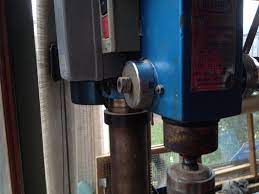TheJay
Member
Hey everyone, I have a very old pillar drill press from 1981 (Draper). It has a green on and red off button on the side. I wondered how I can take power from the drill press when the green/black button is pressed and turn it off when the red button is pressed?

Even better, how could I connect a three way switch so that I can turn it on and off manually, as well as having a position for automatic.
Even better, how could I connect a three way switch so that I can turn it on and off manually, as well as having a position for automatic.





